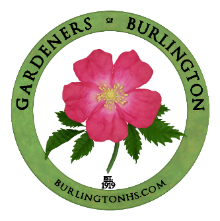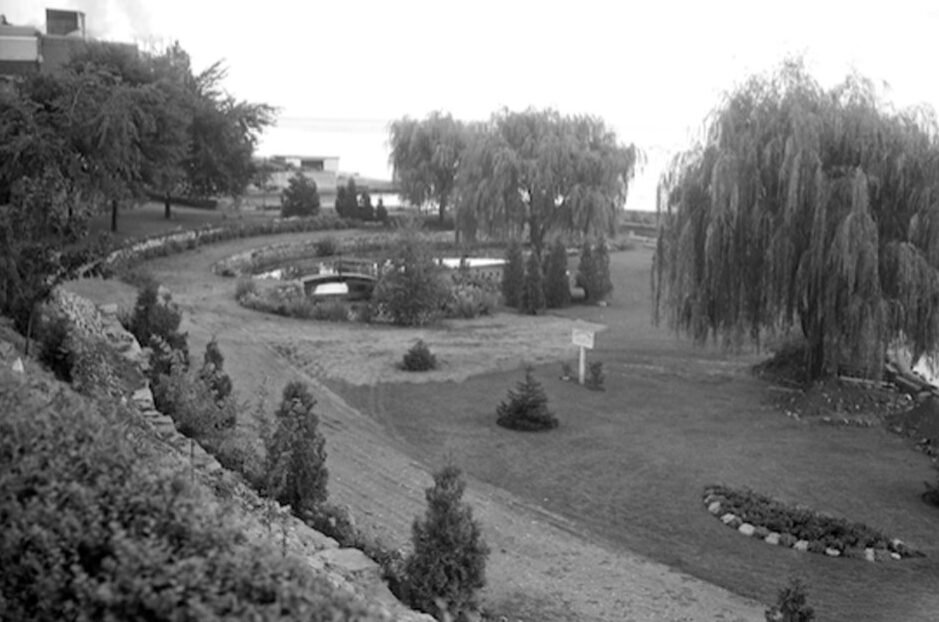The History of The Burlington Horticultural Society
Growing a Legacy
In March of 1919, twenty five Burlington residents formed the Burlington Horticultural Society. Among the members were some of the prominent men of the day, including Rev. George Tebbs, Paul Fisher, Fred Ghent and Spencer Smith. From the minutes of that first meeting we have the purpose of the organization:
“Some of our prominent citizens felt our town could be made much more attractive if we had a Horticultural Society responsible for beautifying vacant street corners, place flower beds at entrances to our town and generally assist our citizens to produce plants, seeds and trees, as well as instructing them on practical horticulture”.
– Inaugural Meeting, 1919
At that first meeting it was proposed to adopt the rose as the town flower and make Burlington famous for its roses. President was the Rev. George Tebbs and Secretary was Mary Townsend. By the end of that first year, the Society membership had increased to 111.
Official government recognition for the new organization came on April 20, 1919. There had been an earlier Burlington Horticultural Association established in 1889. Its purpose had been to increase the practical and scientific knowledge of the area’s fruit growers. The new society was a more urban organization than that association.
In the early years the Society functioned as the Town’s Park Board. Much of the physical work involved in establishing the parks was done by the members of the society. They dug the ground, prepared the soil and did the planting in the first parks. Two of the first parks created by the Society were Gore Park and Brant Park, opposite the Brant Inn. As time went on, the town recognized the work of the society and began to give the group an annual grant. During this time there was only one paid employee, Mr. Fred Feketa. After the Second World War as Burlington expanded, the town took over parks maintenance through the Parks and Recreation Department.

Spencer Smith was a charter member of the society and remained a member for 36 years until his death in 1955. Smith had come to Canada as a Barnardo boy. He settled in Burlington as a young man, married Edith Bell and opened a green grocer store on Brant Street not too far from the lake. He began by planting flowers around his shop and those of his neighbours. He took an active interest in developing town parks as the chairman of the society’s parks committee. It was described as “his intensive hobby”.
In 1920 town property from Nelson Avenue to Burlington Avenue was drained, cleaned up and designated as Lakeside Park. This was the beginnings of what we now call Spencer Smith Park. Smith was particularly interested in developing parkland along the waterfront. Through his efforts the initial small Lakeside Park was expanded and is now the showpiece of the Burlington waterfront. In 1933 under Smith’s leadership members cleaned up the shoreline below Lakeside Park and further developed the park. The park was renamed Spencer Park in 1942. When the Burlington Centennial Committee suggested in 1964 that the name should be changed to Wellington Square Park, there were strong objections led by the Burlington Horticultural Society and the Park retained Smith’s name, becoming known as Spencer Smith Park.
In recognition of his efforts, there is a cairn in Spencer Smith Park with the inscription,
“Erected by the Burlington Horticultural Society in honour and memory of Spencer Smith for his outstanding contribution and leadership in the Beautification of Burlington. He laboured for 25 years on the Executive during continuous membership of 36 years from 1919 – 1955”.
On a piece of town property which is now part of the grounds of Burlington Central High School, Spencer Smith established a town nursery. Hundreds of seedlings were obtained from the government nursery at St. Williams and school children and Scouts helped with the planting of them. These seedlings as they grew became the trees that were planted in many parts of old Burlington.
The Society held its first flower show in the new Lakeside Park in 1920. Membership increased until in 1925 there were 356 members. Two years later the Prince of Wales visited Burlington. Peonies presented by him were planted in Radial Park. In a Souvenir Booklet of Burlington published in 1927, it was noted that the society was doing excellent work in civic beautification. The society continued to urge town council to adopt the rose as the civic flower and finally in 1929 town council did so. The rose collection (garden) in Central Park in front of the Library was started with a one thousand dollar grant from the society and each year new roses are added to the collection. The society has continued to have flower shows over the years, although for a brief time they were discontinued. There have been shows at the Central Library and in the Burlington Mall, but now shows are held three times a year during regular society meetings.
Over the years the society has had photography competitions and beginning in 1969 as part of the society’s 50th anniversary, an annual garden tour has been held. Ten years later on the occasion of the 60th anniversary of the society the annual Civic Rose Awards began.
Membership has varied over the years. The highest membership was in 1950 when there were 548 members.
In the 1980s the Society took on a major project. It created an Honour Roll of Trees which lists over seventy imported and eighty native species. Society members inspected, measured, photographed and catalogued notable trees. A two volume Honour Roll of Trees was presented to the Burlington Central Library. For the 65th anniversary of the organization, a pine tree was planted in La Salle Park.
The society continues to fulfill its original mandate – in 1991 after two years of planning, the Maple Park project was dedicated by Mayor Roly Bird. More recently the society has taken over maintenance of the Perennial Bed in front of the Central Park Bandstand. We continue to provide funds annually to the Public Library for the purchase of books and DVDs on gardening.

